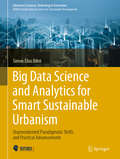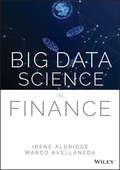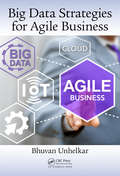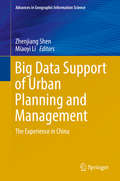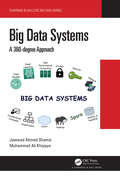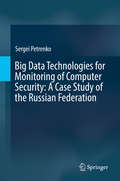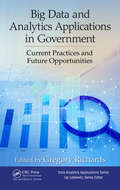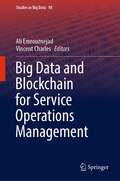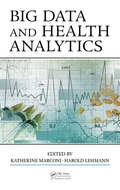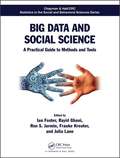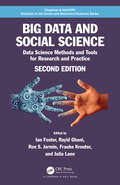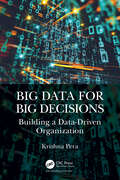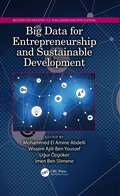- Table View
- List View
Big Data Science and Analytics for Smart Sustainable Urbanism: Unprecedented Paradigmatic Shifts and Practical Advancements (Advances in Science, Technology & Innovation)
by Simon Elias BibriWe are living at the dawn of what has been termed ‘the fourth paradigm of science,’ a scientific revolution that is marked by both the emergence of big data science and analytics, and by the increasing adoption of the underlying technologies in scientific and scholarly research practices. Everything about science development or knowledge production is fundamentally changing thanks to the ever-increasing deluge of data. This is the primary fuel of the new age, which powerful computational processes or analytics algorithms are using to generate valuable knowledge for enhanced decision-making, and deep insights pertaining to a wide variety of practical uses and applications. This book addresses the complex interplay of the scientific, technological, and social dimensions of the city, and what it entails in terms of the systemic implications for smart sustainable urbanism. In concrete terms, it explores the interdisciplinary and transdisciplinary field of smart sustainable urbanism and the unprecedented paradigmatic shifts and practical advances it is undergoing in light of big data science and analytics. This new era of science and technology embodies an unprecedentedly transformative and constitutive power—manifested not only in the form of revolutionizing science and transforming knowledge, but also in advancing social practices, producing new discourses, catalyzing major shifts, and fostering societal transitions. Of particular relevance, it is instigating a massive change in the way both smart cities and sustainable cities are studied and understood, and in how they are planned, designed, operated, managed, and governed in the face of urbanization. This relates to what has been dubbed data-driven smart sustainable urbanism, an emerging approach based on a computational understanding of city systems and processes that reduces urban life to logical and algorithmic rules and procedures, while also harnessing urban big data to provide a more holistic and integrated view or synoptic intelligence of the city. This is increasingly being directed towards improving, advancing, and maintaining the contribution of both sustainable cities and smart cities to the goals of sustainable development. This timely and multifaceted book is aimed at a broad readership. As such, it will appeal to urban scientists, data scientists, urbanists, planners, engineers, designers, policymakers, philosophers of science, and futurists, as well as all readers interested in an overview of the pivotal role of big data science and analytics in advancing every academic discipline and social practice concerned with data–intensive science and its application, particularly in relation to sustainability.
Big Data Science in Finance
by Irene Aldridge Marco AvellanedaExplains the mathematics, theory, and methods of Big Data as applied to finance and investing Data science has fundamentally changed Wall Street—applied mathematics and software code are increasingly driving finance and investment-decision tools. Big Data Science in Finance examines the mathematics, theory, and practical use of the revolutionary techniques that are transforming the industry. Designed for mathematically-advanced students and discerning financial practitioners alike, this energizing book presents new, cutting-edge content based on world-class research taught in the leading Financial Mathematics and Engineering programs in the world. Marco Avellaneda, a leader in quantitative finance, and quantitative methodology author Irene Aldridge help readers harness the power of Big Data. Comprehensive in scope, this book offers in-depth instruction on how to separate signal from noise, how to deal with missing data values, and how to utilize Big Data techniques in decision-making. Key topics include data clustering, data storage optimization, Big Data dynamics, Monte Carlo methods and their applications in Big Data analysis, and more. This valuable book: Provides a complete account of Big Data that includes proofs, step-by-step applications, and code samples Explains the difference between Principal Component Analysis (PCA) and Singular Value Decomposition (SVD) Covers vital topics in the field in a clear, straightforward manner Compares, contrasts, and discusses Big Data and Small Data Includes Cornell University-tested educational materials such as lesson plans, end-of-chapter questions, and downloadable lecture slides Big Data Science in Finance: Mathematics and Applications is an important, up-to-date resource for students in economics, econometrics, finance, applied mathematics, industrial engineering, and business courses, and for investment managers, quantitative traders, risk and portfolio managers, and other financial practitioners.
Big Data Strategies for Agile Business
by Bhuvan UnhelkarAgile is a set of values, principles, techniques, and frameworks for the adaptable, incremental, and efficient delivery of work. Big Data is a rapidly growing field that encompasses crucial aspects of data such as its volume, velocity, variety, and veracity. This book outlines a strategic approach to Big Data that will render a business Agile. It discusses the important competencies required to streamline and focus on the analytics and presents a roadmap for implementing such analytics in business.
Big Data Support of Urban Planning and Management: The Experience in China (Advances in Geographic Information Science)
by Zhenjiang Shen Miaoyi LiIn the era of big data, this book explores the new challenges of urban-rural planning and management from a practical perspective based on a multidisciplinary project. Researchers as contributors to this book have accomplished their projects by using big data and relevant data mining technologies for investigating the possibilities of big data, such as that obtained through cell phones, social network systems and smart cards instead of conventional survey data for urban planning support. This book showcases active researchers who share their experiences and ideas on human mobility, accessibility and recognition of places, connectivity of transportation and urban structure in order to provide effective analytic and forecasting tools for smart city planning and design solutions in China.
Big Data Systems: A 360-degree Approach
by Jawwad Ahmad ShamsiBig Data Systems encompass massive challenges related to data diversity, storage mechanisms, and requirements of massive computational power. Further, capabilities of big data systems also vary with respect to type of problems. For instance, distributed memory systems are not recommended for iterative algorithms. Similarly, variations in big data systems also exist related to consistency and fault tolerance. The purpose of this book is to provide a detailed explanation of big data systems. The book covers various topics including Networking, Security, Privacy, Storage, Computation, Cloud Computing, NoSQL and NewSQL systems, High Performance Computing, and Deep Learning. An illustrative and practical approach has been adopted in which theoretical topics have been aided by well-explained programming and illustrative examples. Key Features: Introduces concepts and evolution of Big Data technology. Illustrates examples for thorough understanding. Contains programming examples for hands on development. Explains a variety of topics including NoSQL Systems, NewSQL systems, Security, Privacy, Networking, Cloud, High Performance Computing, and Deep Learning. Exemplifies widely used big data technologies such as Hadoop and Spark. Includes discussion on case studies and open issues. Provides end of chapter questions for enhanced learning.
Big Data Technologies for Monitoring of Computer Security: A Case Study of the Russian Federation
by Sergei PetrenkoThis timely book offers rare insight into the field of cybersecurity in Russia -- a significant player with regard to cyber-attacks and cyber war. Big Data Technologies for Monitoring of Computer Security presents possible solutions to the relatively new scientific/technical problem of developing an early-warning cybersecurity system for critically important governmental information assets. Using the work being done in Russia on new information security systems as a case study, the book shares valuable insights gained during the process of designing and constructing open segment prototypes of this system. Most books on cybersecurity focus solely on the technical aspects. But Big Data Technologies for Monitoring of Computer Security demonstrates that military and political considerations should be included as well. With a broad market including architects and research engineers in the field of information security, as well as managers of corporate and state structures, including Chief Information Officers of domestic automation services (CIO) and chief information security officers (CISO), this book can also be used as a case study in university courses.
Big Data Visualization
by James MillerThis book is for data analysts or those with a basic knowledge of big data analysis who want to learn big data visualization in order to make their analysis more useful. You need sufficient knowledge of big data platform tools such as Hadoop and also some experience with programming languages such as R. This book will be great for those who are familiar with conventional data visualizations and now want to widen their horizon by exploring big data visualizations.
Big Data and Analytics Applications in Government: Current Practices and Future Opportunities (Data Analytics Applications)
by Gregory RichardsWithin this context, big data analytics (BDA) can be an important tool given that many analytic techniques within the big data world have been created specifically to deal with complexity and rapidly changing conditions. The important task for public sector organizations is to liberate analytics from narrow scientific silos and expand it across internally to reap maximum benefit across their portfolios of programs. This book highlights contextual factors important to better situating the use of BDA within government organizations and demonstrates the wide range of applications of different BDA techniques. It emphasizes the importance of leadership and organizational practices that can improve performance. It explains that BDA initiatives should not be bolted on but should be integrated into the organization’s performance management processes. Equally important, the book includes chapters that demonstrate the diversity of factors that need to be managed to launch and sustain BDA initiatives in public sector organizations.
Big Data and Artificial Intelligence in Digital Finance: Increasing Personalization and Trust in Digital Finance using Big Data and AI
by John Soldatos Dimosthenis KyriazisThis open access book presents how cutting-edge digital technologies like Big Data, Machine Learning, Artificial Intelligence (AI), and Blockchain are set to disrupt the financial sector. The book illustrates how recent advances in these technologies facilitate banks, FinTech, and financial institutions to collect, process, analyze, and fully leverage the very large amounts of data that are nowadays produced and exchanged in the sector. To this end, the book also describes some more the most popular Big Data, AI and Blockchain applications in the sector, including novel applications in the areas of Know Your Customer (KYC), Personalized Wealth Management and Asset Management, Portfolio Risk Assessment, as well as variety of novel Usage-based Insurance applications based on Internet-of-Things data. Most of the presented applications have been developed, deployed and validated in real-life digital finance settings in the context of the European Commission funded INFINITECH project, which is a flagship innovation initiative for Big Data and AI in digital finance. This book is ideal for researchers and practitioners in Big Data, AI, banking and digital finance.
Big Data and Blockchain for Service Operations Management (Studies in Big Data #98)
by Ali Emrouznejad Vincent CharlesThis book aims to provide the necessary background to work with big data blockchain by introducing some novel applications in service operations for both academics and interested practitioners, and to benefit society, industry, academia, and government. Presenting applications in a variety of industries, this book intends to cover theory, research, development, and applications of big data and blockchain, as embedded in the fields of mathematics, engineering, computer science, physics, economics, business, management, and life sciences, to help service operations management.
Big Data and Business Analytics
by Jay Liebowitz"The chapters in this volume offer useful case studies, technical roadmaps, lessons learned, and a few prescriptions todo this, avoid that.'"-From the Foreword by Joe LaCugna, Ph.D., Enterprise Analytics and Business Intelligence, Starbucks Coffee CompanyWith the growing barrage of "big data," it becomes vitally important for organizations to mak
Big Data and Cloud Computing for Development: Lessons from Key Industries and Economies in the Global South
by Nir Kshetri Diana Carolina Rojas Torres Torbjörn FredrikssonThis book provides a framework for evaluating big data and cloud computing based on how they evolve to fit users’ needs in developing countries in key areas, such as agriculture and education. The authors discuss how this framework can be utilized by businesses, governments, and consumers to accelerate economic growth and overcome information and communication barriers. By examining the ways in which cloud computing can drive social, economic, and environmental transformation, readers gain a nuanced understanding of the opportunities and challenges these technologies offer. The authors also provide an authoritative and up-to-date account of big data’s diffusion into a wide range of developing economies, such as Brazil and China, illustrating key concepts through in-depth case studies. Special attention is paid to economic development in the context of the new Sustainable Development Goals formulated by the United Nations, introducing readers to the most modern standard of economic evaluation. Students of information management, entrepreneurship, and development, as well as policy makers, researchers, and practitioners, will find Big Data and Cloud Computing for Development an interesting read and a useful reference source.
Big Data and Health Analytics
by Katherine Marconi Harold LehmannThis book provides frameworks, use cases, and examples that illustrate the role of big data and analytics in modern health care, including how public health information can inform health delivery. Written for health care professionals and executives, this book presents the current thinking of academic and industry researchers and leaders from around the world. Using non-technical language, it includes case studies that illustrate the business processes that underlie the use of big data and health analytics to improve health care delivery.
Big Data and Innovation in Tourism, Travel, and Hospitality: Managerial Approaches, Techniques, and Applications
by Marianna Sigala Roya Rahimi Mike ThelwallThis book brings together multi-disciplinary research and practical evidence about the role and exploitation of big data in driving and supporting innovation in tourism. It also provides a consolidated framework and roadmap summarising the major issues that both researchers and practitioners have to address for effective big data innovation.The book proposes a process-based model to identify and implement big data innovation strategies in tourism. This process framework consists of four major parts: 1) inputs required for big data innovation; 2) processes required to implement big data innovation; 3) outcomes of big data innovation; and 4) contextual factors influencing big data exploitation and advances in big data exploitation for business innovation.
Big Data and Machine Learning in Quantitative Investment (Wiley Finance)
by Tony GuidaGet to know the ‘why’ and ‘how’ of machine learning and big data in quantitative investment Big Data and Machine Learning in Quantitative Investment is not just about demonstrating the maths or the coding. Instead, it’s a book by practitioners for practitioners, covering the questions of why and how of applying machine learning and big data to quantitative finance. The book is split into 13 chapters, each of which is written by a different author on a specific case. The chapters are ordered according to the level of complexity; beginning with the big picture and taxonomy, moving onto practical applications of machine learning and finally finishing with innovative approaches using deep learning. • Gain a solid reason to use machine learning • Frame your question using financial markets laws • Know your data• Understand how machine learning is becoming ever more sophisticated Machine learning and big data are not a magical solution, but appropriately applied, they are extremely effective tools for quantitative investment — and this book shows you how.
Big Data and Social Science: A Practical Guide to Methods and Tools
by Frauke Kreuter Julia Lane Ian Foster Rayid Ghani Ron S. JarminBig Data and Social Science: A Practical Guide to Methods and Tools shows how to apply data science to real-world problems in both research and the practice. The book provides practical guidance on combining methods and tools from computer science, statistics, and social science. This concrete approach is illustrated throughout using an important national problem, the quantitative study of innovation. The text draws on the expertise of prominent leaders in statistics, the social sciences, data science, and computer science to teach students how to use modern social science research principles as well as the best analytical and computational tools. It uses a real-world challenge to introduce how these tools are used to identify and capture appropriate data, apply data science models and tools to that data, and recognize and respond to data errors and limitations.
Big Data and Social Science: Data Science Methods and Tools for Research and Practice (Chapman & Hall/CRC Statistics in the Social and Behavioral Sciences)
by Ian Foster, Rayid Ghani, Ron S. Jarmin, Frauke Kreuter and Julia LaneBig Data and Social Science: Data Science Methods and Tools for Research and Practice, Second Edition shows how to apply data science to real-world problems, covering all stages of a data-intensive social science or policy project. Prominent leaders in the social sciences, statistics, and computer science as well as the field of data science provide a unique perspective on how to apply modern social science research principles and current analytical and computational tools. The text teaches you how to identify and collect appropriate data, apply data science methods and tools to the data, and recognize and respond to data errors, biases, and limitations. Features: Takes an accessible, hands-on approach to handling new types of data in the social sciences Presents the key data science tools in a non-intimidating way to both social and data scientists while keeping the focus on research questions and purposes Illustrates social science and data science principles through real-world problems Links computer science concepts to practical social science research Promotes good scientific practice Provides freely available workbooks with data, code, and practical programming exercises, through Binder and GitHub New to the Second Edition: Increased use of examples from different areas of social sciences New chapter on dealing with Bias and Fairness in Machine Learning models Expanded chapters focusing on Machine Learning and Text Analysis Revamped hands-on Jupyter notebooks to reinforce concepts covered in each chapter This classroom-tested book fills a major gap in graduate- and professional-level data science and social science education. It can be used to train a new generation of social data scientists to tackle real-world problems and improve the skills and competencies of applied social scientists and public policy practitioners. It empowers you to use the massive and rapidly growing amounts of available data to interpret economic and social activities in a scientific and rigorous manner.
Big Data at Work
by Thomas H. DavenportGo ahead, be skeptical about big data. The author was-at first.When the term "big data" first came on the scene, bestselling author Tom Davenport (Competing on Analytics, Analytics at Work) thought it was just another example of technology hype. But his research in the years that followed changed his mind.Now, in clear, conversational language, Davenport explains what big data means-and why everyone in business needs to know about it. Big Data at Work covers all the bases: what big data means from a technical, consumer, and management perspective; what its opportunities and costs are; where it can have real business impact; and which aspects of this hot topic have been oversold.This book will help you understand: Why big data is important to you and your organization What technology you need to manage it How big data could change your job, your company, and your industry How to hire, rent, or develop the kinds of people who make big data work The key success factors in implementing any big data project How big data is leading to a new approach to managing analyticsWith dozens of company examples, including UPS, GE, Amazon, United Healthcare, Citigroup, and many others, this book will help you seize all opportunities-from improving decisions, products, and services to strengthening customer relationships. It will show you how to put big data to work in your own organization so that you too can harness the power of this ever-evolving new resource.
Big Data for Big Decisions: Building a Data-Driven Organization
by Krishna PeraBuilding a data-driven organization (DDO) is an enterprise-wide initiative that may consume and lock up resources for the long term. Understandably, any organization considering such an initiative would insist on a roadmap and business case to be prepared and evaluated prior to approval. This book presents a step-by-step methodology in order to create a roadmap and business case, and provides a narration of the constraints and experiences of managers who have attempted the setting up of DDOs. The emphasis is on the big decisions – the key decisions that influence 90% of business outcomes – starting from decision first and reengineering the data to the decisions process-chain and data governance, so as to ensure the right data are available at the right time, every time. Investing in artificial intelligence and data-driven decision making are now being considered a survival necessity for organizations to stay competitive. While every enterprise aspires to become 100% data-driven and every Chief Information Officer (CIO) has a budget, Gartner estimates over 80% of all analytics projects fail to deliver intended value. Most CIOs think a data-driven organization is a distant dream, especially while they are still struggling to explain the value from analytics. They know a few isolated successes, or a one-time leveraging of big data for decision making does not make an organization data-driven. As of now, there is no precise definition for data-driven organization or what qualifies an organization to call itself data-driven. Given the hype in the market for big data, analytics and AI, every CIO has a budget for analytics, but very little clarity on where to begin or how to choose and prioritize the analytics projects. Most end up investing in a visualization platform like Tableau or QlikView, which in essence is an improved version of their BI dashboard that the organization had invested into not too long ago. The most important stakeholders, the decision-makers, are rarely kept in the loop while choosing analytics projects. This book provides a fail-safe methodology for assured success in deriving intended value from investments into analytics. It is a practitioners’ handbook for creating a step-by-step transformational roadmap prioritizing the big data for the big decisions, the 10% of decisions that influence 90% of business outcomes, and delivering material improvements in the quality of decisions, as well as measurable value from analytics investments. The acid test for a data-driven organization is when all the big decisions, especially top-level strategic decisions, are taken based on data and not on the collective gut feeling of the decision makers in the organization.
Big Data for Entrepreneurship and Sustainable Development (Big Data for Industry 4.0)
by Imen Ben Slimene Uğur Özgöker Amine Abdelli, Mohammed El Youssef, Wissem Ajili-BenThis book provides insight for researchers and decision-makers on the application of data in the entrepreneurship and sustainable development sector. This book covers how Big Data for Industry 4.0 and entrepreneurship are effective in resolving business, social, and economic problems.The book discusses how entrepreneurs use Big Data to cut costs and minimize the waste of time. It offers how using Big Data can increase efficiency, enables the studying of competitors, can improve the pricing of products, increase sales and loyalty, and can ensure the right people are hired. The book presents how decision-makers can make use of Big Data to resolve economic and social problems. Analyze the development of the economy and enhance the business climate.This book is for researchers, PhD students, and entrepreneurs and can also be of interest for transforming governments as well as businesses.
Big Data for Insurance Companies
by Jacques Janssen Marine Corlosquet-HabartThis book will be a “must” for people who want good knowledge of big data concepts and their applications in the real world, particularly in the field of insurance. It will be useful to people working in finance and to masters students using big data tools. The authors present the bases of big data: data analysis methods, learning processes, application to insurance and position within the insurance market. Individual chapters a will be written by well-known authors in this field.
Big Data for Managers: Creating Value
by Atal Malviya Mike MalmgrenIn today’s fast growing digital world, the web, mobile, social networks and other digital platforms are producing enormous amounts of data that hold intelligence and valuable information. Correctly used it has the power to create sustainable value in different forms for businesses. The commonly used term for this data is Big Data, which includes structured, unstructured and hybrid structured data. However, Big Data is of limited value unless insightful information can be extracted from the sources of data. The solution is Big Data analytics, and how managers and executives can capture value from this vast resource of information and insights. This book develops a simple framework and a non-technical approach to help the reader understand, digest and analyze data, and produce meaningful analytics to make informed decisions. It will support value creation within businesses, from customer care to product innovation, from sales and marketing to operational performance. The authors provide multiple case studies on global industries and business units, chapter summaries and discussion questions for the reader to consider and explore. Big Data for Managers also presents small cases and challenges for the reader to work on – making this a thorough and practical guide for students and managers.
Big Data for Regional Science (Routledge Advances in Regional Economics, Science and Policy)
by Zhenhua Chen Laurie A SchintlerRecent technological advancements and other related factors and trends are contributing to the production of an astoundingly large and rapidly accelerating collection of data, or ‘Big Data’. This data now allows us to examine urban and regional phenomena in ways that were previously not possible. Despite the tremendous potential of big data for regional science, its use and application in this context is fraught with issues and challenges. This book brings together leading contributors to present an interdisciplinary, agenda-setting and action-oriented platform for research and practice in the urban and regional community. This book provides a comprehensive, multidisciplinary and cutting-edge perspective on big data for regional science. Chapters contain a collection of research notes contributed by experts from all over the world with a wide array of disciplinary backgrounds. The content is organized along four themes: sources of big data; integration, processing and management of big data; analytics for big data; and, higher level policy and programmatic considerations. As well as concisely and comprehensively synthesising work done to date, the book also considers future challenges and prospects for the use of big data in regional science. Big Data for Regional Science provides a seminal contribution to the field of regional science and will appeal to a broad audience, including those at all levels of academia, industry, and government.
Big Data for Twenty-First-Century Economic Statistics (National Bureau of Economic Research Studies in Income and Wealth #79)
by Katharine G. Abraham, Ron S. Jarmin, Brian C. Moyer, and Matthew D. ShapiroThe papers in this volume analyze the deployment of Big Data to solve both existing and novel challenges in economic measurement. The existing infrastructure for the production of key economic statistics relies heavily on data collected through sample surveys and periodic censuses, together with administrative records generated in connection with tax administration. The increasing difficulty of obtaining survey and census responses threatens the viability of existing data collection approaches. The growing availability of new sources of Big Data—such as scanner data on purchases, credit card transaction records, payroll information, and prices of various goods scraped from the websites of online sellers—has changed the data landscape. These new sources of data hold the promise of allowing the statistical agencies to produce more accurate, more disaggregated, and more timely economic data to meet the needs of policymakers and other data users. This volume documents progress made toward that goal and the challenges to be overcome to realize the full potential of Big Data in the production of economic statistics. It describes the deployment of Big Data to solve both existing and novel challenges in economic measurement, and it will be of interest to statistical agency staff, academic researchers, and serious users of economic statistics.
Big Data for Twenty-First-Century Economic Statistics (National Bureau of Economic Research Studies in Income and Wealth #79)
by Katharine G. Abraham, Ron S. Jarmin, Brian C. Moyer, and Matthew D. ShapiroThe papers in this volume analyze the deployment of Big Data to solve both existing and novel challenges in economic measurement. The existing infrastructure for the production of key economic statistics relies heavily on data collected through sample surveys and periodic censuses, together with administrative records generated in connection with tax administration. The increasing difficulty of obtaining survey and census responses threatens the viability of existing data collection approaches. The growing availability of new sources of Big Data—such as scanner data on purchases, credit card transaction records, payroll information, and prices of various goods scraped from the websites of online sellers—has changed the data landscape. These new sources of data hold the promise of allowing the statistical agencies to produce more accurate, more disaggregated, and more timely economic data to meet the needs of policymakers and other data users. This volume documents progress made toward that goal and the challenges to be overcome to realize the full potential of Big Data in the production of economic statistics. It describes the deployment of Big Data to solve both existing and novel challenges in economic measurement, and it will be of interest to statistical agency staff, academic researchers, and serious users of economic statistics.
